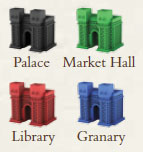
Civilization Buildings

The advanced game uses four civilization buildings. They include a palace, a library, a market hall, and a granary. During setup, place these buildings next to the board near the monuments.
When a player places one of his tiles on the board so that it becomes part of an uninterrupted vertical or horizontal line of three or more tiles of the same color, that player may take the corresponding color building from beside the board and place it on any one of the color tiles in the line.
If the corresponding building is already on the board, the player may remove the building from its current location and place it on any one of the color tiles in the new line, provided the new line is longer than the line where the building is currently located.
If a building is on a tile that is part of both a horizontal line and a vertical line, the new line must be longer than each of the building's current lines.
Civilization buildings must be placed before building a monument or erecting a wonder (if able).
When a player places a tile in a kingdom containing a building of the corresponding color, the reward for the respective leader (or the king if the leader is absent) increases from one to two victory points. (Rewards for conflicts or monuments remain unaffected).
Players must resolve conflicts before building placement. A tile directly under a building counts in conflicts and cannot be removed. Catastrophe tiles cannot be played on a tile that is under a building. If you flip over a tile that is under a building in order to build a monument or wonder, remove the building and place it next to the board for future use.
Example: A granary can be placed on the horizontal line of three farms A. A library can be placed on the vertical line of three temples B. The trio of markets C is not in a straight line and so a market hall cannot be placed there. If a settlement were placed at D, a player could place a palace on that newly created vertical line of settlements.

Advanced Game Board
The advanced game board is an alternate board printed on the back of the original board. It is differentiated by a blue border (rather than gold). It uses a different map and contains four extra treasures. When you play with the alternate board, place one temple with a treasure on each of the fourteen Shedu spaces. Then, play by the original rules.
When a player collects a treasure from a kingdom containing more than one treasure, he must first collect those treasures from spaces outlined with the special border.

English Variant
In order to restrict the opportunity to discard extra tiles during a conflict that do not influence its resolution, the following variant may be adopted: the attacker may commit extra tiles if thereafter his total exceeds the current strength of the defender.
If he has no chance of winning the conflict, he cannot commit any extra tiles. The defender can commit extra tiles only in order to win the conflict by establishing a tie. No more, no less.
Wonder Variant

The wonder is a special five-tile monument with a cross-like shape. A player may erect the wonder when he creates a cross configuration of five tiles of a single color.
If a player chooses to erect a wonder, he discards the five tiles that formed the cross configuration and replaces them with the wonder tile, which cannot be destroyed. Place the Shedu idol on top of the wonder tile (see A below). The wonder tile still counts as part of regions and kingdoms, and it can link leaders and tiles.
However, it no longer counts for any other functions (e.g., as supporters in conflicts). All other monument rules apply to the wonder. At the end of the active player's turn, if he has a king in a kingdom with the wonder, he gains 1 victory point token in the color of his choice.
Continue Reading

